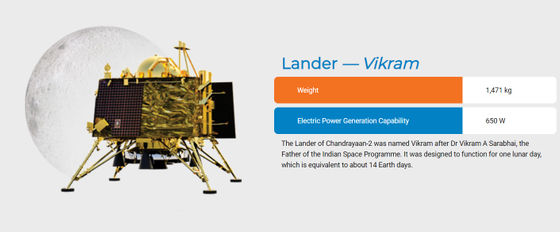Indian government officially acknowledges landing ship crash of lunar probe Chandrayaan 2

by
The Indian government has officially admitted that the lunar lander on board the Chandrayaan-2 lunar probe failed to land on the moon and was destroyed.
New details emerge about failed lunar landings - SpaceNews.com
https://spacenews.com/new-details-emerge-about-failed-lunar-landings/
India Admits Its Moon Lander Crashed, Cites Problem with Braking Thrusters | Space
https://www.space.com/india-admits-moon-lander-crash.html
Chandrayaan-3: Second bid to land on Moon by November 2020 | India News - Times of India
https://timesofindia.indiatimes.com/india/chandrayaan-3-second-bid-to-land-on-moon-by-november-2020/articleshow/72047390.cms
The Indian Space Research Organization (ISRO) launched the GSLV-Mk III-M1 rocket carrying Chandrayaan-2 on July 22, 2019. Although the rocket was originally scheduled to launch on July 15th, a defect was discovered and the launch was postponed, but the launch was a success. The mission in lunar orbit began on August 20.
For Chandrayaan No. 2, you can understand it in one shot by reading the following article.
India reveals the whole space expansion plan aiming to ``enter the fourth space power'' - GIGAZINE

Chandrayaan-2 consists of the ``Orbiter'', which conducts exploration from lunar orbit, the ``Bikram'' lander, and the ``Pragian'' exploration rover. detached. However, Bikram lost communication at the end of September 7 when it reached a point about 2 km from the moon. On September 8, the orbiter's camera captured Bikram near the planned landing site, and an attempt was made to restore communication.
More than two months later, on November 20, Minister of State for Space Development Jitendra Singh submitted a report (PDF file) to the Indian Parliament Lok Sabha , saying, ``Bikram will be within 500m of the designated landing site. I made a hard landing ,' and admitted that Bikram had crashed. This is the first time the Indian government has officially admitted that the moon landing failed.

According to reports, Bikram began its descent from 30 to 7.4 kilometers from the lunar surface, slowing its speed from 1,683 meters per second to 146 meters per second during the first phase, while the second phase of the landing was designed to It crashed on the moon at a speed exceeding the strength. The impact at that time is believed to have destroyed Bikram and the exploration rover. The report did not clarify the cause of the insufficient deceleration, but there are also reports that the deceleration thrusters may have malfunctioned.
Singh said in the report, 'Most of the process was successful, including launch, maneuvering in orbit, detachment of the lander, retrofiring, and rough deceleration in the first phase.' All the equipment we have is functioning properly and is providing valuable scientific data.'He said he would concentrate on the investigation with the orbiter that observes the lunar surface from orbit.
According to information obtained by The Times of India , a major Indian letter, ISRO has already begun development of Chandrayaan-3, a successor project to Chandrayaan-2, and it will be possible as early as November 2020. It is expected to hit the second challenge.
Related Posts:






